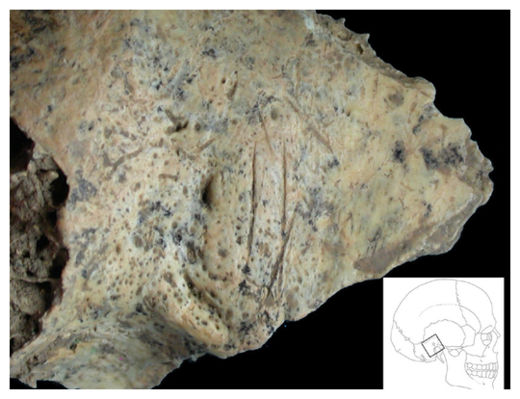
Early humans wore jewelry and likely practiced cannibalism, suggest remains of the earliest known Homo sapiens from southeastern Europe.
The remains, described in PLoS One, date to 32,000 years ago and represent the oldest direct evidence for anatomically modern humans in a well-documented context. The human remains are also the oldest known for our species in Europe to show post-mortem cut marks.
"Our observations indicate a post-mortem treatment of human corpses including the selection of the skull," co-author Stephane Pean, a paleozoologist and archaeologist at the National Museum of Natural History in Paris, told Discovery News. "We demonstrate that this treatment was not for nutritional purposes, according to comparison with game butchery treatment, so it is not a dietary cannibalism."
Instead, Pean said that he and his colleagues believe that the "observed treatment of the human body, together with the presence of body ornaments, indicates rather a mortuary ritual: either a ritual cannibalism or a specific mortuary practice for secondary disposal."
The scientists made those assessments after studying human remains and artifacts discovered at a shelter-cave site called Buran-Kaya III in the Ukraine.
Although this is a more complete archaeological setting, the actual first known Homo sapiens from Europe dates to 34,000 years ago from Pestera cu Oase in Romania. Yet another single modern human from Kostenki 1 in Russia dates to 33,000 years ago.
The age of all of these discoveries intriguingly suggests that these first members of our species in Europe may have coexisted with Neanderthals.
"Through our work in progress, some of the expected results could help to better understand the transition period of late Neanderthal and early Homo sapiens settlements in Europe," Pean said.
While the possible Neanderthal connection remains a mystery, it is more evident that these early anatomically modern humans wore mammoth bling.
Artifacts excavated at the site include five mammoth beads, one engraved plate made out of mammoth ivory and 35 perforated shells. Since no mammoth remains or craft debris were found, it's likely that the objects were made off-site.
The remains of pointed bone tools and stone projectiles indicate these early Europeans were active hunters with busy associated tool and weapon-making industries.
The discoveries support that the hunter-gatherers "repeatedly settled the rock shelter of Buran-Kaya III as a temporary hunting camp, and they mostly hunted saiga antelopes," Pean said.
Marcel Otte, a professor of prehistory at the University of Liege, has also excavated at Buran-Kaya III. He told Discovery News that he and his team found evidence for a 30,000-year-old culture at the same site, indicating the region was continuously inhabited for thousands of years after the first modern humans arrived.
Marylene Patou-Mathis, director of the Archaeozoology Unit at the National Museum of Natural History in Paris, told Discovery News that Pean and colleagues' "paper is very important and I agree with the results, which are absolutely new. I am particularly interested in the traces of cannibalism, which are well demonstrated."
She is also interested in the possible Neanderthal connections.
Patou-Mathis explained, "The area of Crimea, with the site of Buran Kaya and another site, Siuren, is very important to question the coexistence of two humankinds, Neanderthal and Homo sapiens, and two cultures on the same territory."
Pean and his team are currently involved in another dig at the same site, "so we are expecting new discoveries," he said.



I don't buy it.
In 30,000 years from now if someone where to excavate the crash site of the rugby team in the Andy Mnts they would conclude that earlier Humans were cannibales when in fact this is not true but an isolated incident.
If early man practiced Cannibalizim then none of us would be here today.
Junk Science if you ask me.